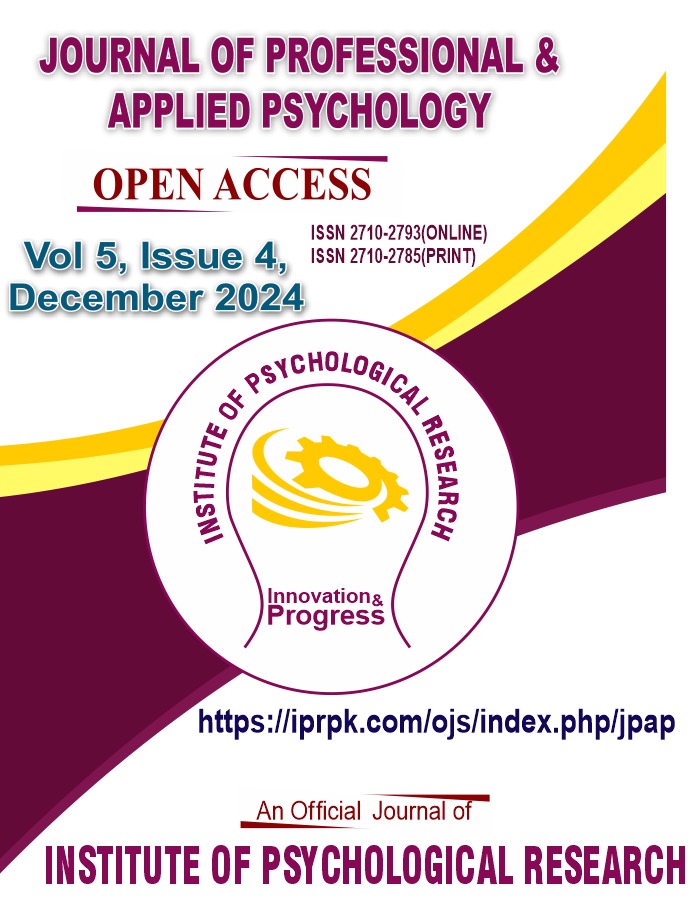Impact of Job Stress on Mental Health and Work-Life Balance: Cross-Sectional Study
DOI:
https://doi.org/10.52053/jpap.v5i4.322Keywords:
Burnout, Employee Well-being, Job Stress, Mental Health, Work-Life BalanceAbstract
This study examines the impact of job stress on university teachers from government and private universities in Multan, and how it affects their mental health and work-life balance. Data was collected from (N=140) university teachers using a convenience sampling method. The scales used were Workplace Stress scale (Rosenfeld, 1988), Psychological Wellbeing scale (Ryff et al., 2007) and Work Balance Questioner (Brough et al., 2014). The results indicated a strong negative correlation (r=-.07) between job stress and mental health, suggesting that mental health problems arise from job stress. Furthermore, there was an inverse relationship between job stress and work-life balance, with an (R2=-.02). Additionally, there was a negative correlation between mental health and work-life balance, as indicated by (R2=.08). The study also investigated gender disparities and found that female teachers exhibited a higher level of mental health (M=164.52) compared to male. The proposes implications for mental health and work life balance for university teachers.
References
Alphin, M. (2022). The concept of mental health in psychoanalytic theories and its consequences on stress in the workplace. [Master's thesis]. Grand Canyon University. ProQuest Dissertations Publishing.
Arif, A. L., Rivai, H. A., & Yulihasri, Y. (2022). Impact of job stress on job performance of health worker with work life balance as mediating variable. Management Analysis Journal, 11(1), 103-109.
Bell, S., & Morse, S. (2012). Sustainability indicators: Measuring the immeasurable? Routledge. https://doi.org/10.4324/9781849772720
Branham, L. (2005). Planning to become an employer of choice. Journal of Organizational Excellence, 24(3), 57-68. https://doi.org/10.1002/joe.20053
Brough, P., Timms, C., O'Driscoll, M. P., Kalliath, T., Siu, O.-L., Sit, C., & Lo, D. (2014). Work-Life Balance Scale [Database record]. APA PsycTests.https://doi.org/10.1037/t61357-000
Brown, D. S. (2023). Components of burnout in mental health counselors and perception of authentic leadership (Doctoral dissertation, Grand Canyon University). ProQuest Dissertations.
Daipuria, P., & Kakar, D. (2013). Work-life balance for working parents: Perspectives and strategies. Journal of Strategic Human Resource Management, 2(1). 45-52.
Dietrich, A., & Wanzenried, G. (2014). The determinants of commercial banking profitability in low-, middle-, and high-income countries. The Quarterly Review of Economics and Finance, 54(3), 337-354. https://doi.org/10.1016/j.qref.2014.03.001
Gibson, R., Lanctot, M., Burch, N., Szafron, D., & Bowling, M. (2012). Generalized sampling and variance in counterfactual regret minimization. Proceedings of the AAAI Conference on Artificial Intelligence, 26(1), 1355-1361. https://doi.org/10.1609/aaai.v26i1.8288
Gnanaselvi, G., & Shanmugapriya, S. (2018). Job stress among women employees. Age, 18(25), 41-48.
Hasin, D. S., Borodovsky, J., Shmulewitz, D., Walsh, C., Struble, C. A., Livne, O., Habib, M. I., Fink, D. S., Aharonovich, E., & Budney, A. (2023). Adult use of highly-potent ?9-THC cannabis concentrate products by US state cannabis legalization status, 2021. Addictive Behaviors, 140, 107617. https://doi.org/10.1016/j.addbeh.2023.107617
Heffernan, J., & Pilkington, P. (2011). Supported employment for persons with mental illness: Systematic review of the effectiveness of individual placement and support in the UK. Journal of Mental Health, 20(4), 368-380. https://doi.org/10.3109/09638237.2011.55615
Henderson, J. V., Storeygard, A., & Weil, D. N. (2012). Measuring economic growth from outer space. American Economic Review, 102(2), 994-1028. https://doi.org/10.1257/aer.102.2.994
Irvin, M., Byun, S. Y., Smiley, W. S., & Hutchins, B. C. (2017). Relation of opportunity to learn advanced math to the educational attainment of rural youth. American Journal of Education, 123(3), 475-510. https://doi.org/10.1086/691024
Izdihar, A. F., & Ab Latiff, D. S. (2023). Unraveling the impact of job stress, work-life balance and work environment on job satisfaction: A study on Malaysian Anti-Corruption Commission Investigation Officers. Information Management and Business Review, 15(3), 303-311. https://doi.org/10.5430/imbr.v15n3p303
Jehangir, A., Tanveer, A., Yousuf, A. R., Masood, A., & Naqash, A. H. (2011). Geochemistry and irrigation quality of groundwater along river Jhelum in South Kashmir, India. Recent Research in Science and Technology, 3(6), 65-72.
Jones, C., Smith-MacDonald, L., Brown, M. R. G., Pike, A., Vermetten, E., & Brémault-Phillips, S. (2022). Quantitative changes in mental health measures with 3MDR treatment for Canadian military members and veterans. Brain and Behavior, 12(8), e2694. https://doi.org/10.1002/brb3.2694
Kapur, N., Kapur, R., Varma, M., Batra, C., & Sharma, B. B. (2022). Fistula in Ano—A 2-year prevalence study on North Indian rural population. Journal of Gastrointestinal and Abdominal Radiology, 5(03), 140-147. https://doi.org/10.1055/s-0042-1742597
Kaur, G. (2017). The importance of digital marketing in the tourism industry. International Journal of Research-Granthaalayah, 5(6), 72-77. https://doi.org/10.29121/granthaalayah.v5.i6.2017.2011
Kaushal, P., & Vashisht, S. (2021). Protean career orientation, career decision self-efficacy and career outcomes of Millennial IT professionals. Management and Labor Studies, 46(3), 248-262. https://doi.org/10.1177/02580409211009989
Kelly, M., Connolly, L., & Dean, M. (2020). Public awareness and risk perceptions of endocrine-disrupting chemicals: A qualitative study. International Journal of Environmental Research and Public Health, 17(21), 7778. https://doi.org/10.3390/ijerph17217778
Levinson, W., Lesser, C. S., & Epstein, R. M. (2010). Developing physician communication skills for patient-centered care. Health Affairs, 29(7), 1310-1318. https://doi.org/10.1377/hlthaff.2009.0450
Lunau, T., Bambra, C., Eikemo, T. A., van Der Wel, K. A., & Dragano, N. (2014). A balancing act? Work–life balance, health and well-being in European welfare states. The European Journal of Public Health, 24(3), 422-427. https://doi.org/10.1093/eurpub/cku010
Maharani, A., & Tamara, D. (2024). The occupational stress and work-life balance on turnover intentions with job satisfaction as a mediating factor. SA Journal of Human Resource Management, 22 (1). https://hdl.handle.net/10520/ejc-sajhrm_v22_n1_a2369
Maslach, C., & Leiter, M. P. (2016). Understanding the burnout experience: Recent research and its implications for psychiatry. World Psychiatry, 15(2), 103-111. https://doi.org/10.1002/wps.20311
Mensah, B. A., Ndong, I. C., Quashie, P. K., Guichet, E., Abuaku, B., Effah-Baafi, Y., Tepala, K., Asiedu, K., Appiedu-Addos, N. A., Obbeng, L. B., Amponash, J. A., Kusi, K. A., Ofori, M., Ayouba, A., Courtin, D., Tahar, R., Delaporte, E., Awandare, G., & Ndam, N. T. (2022). Population-based sero-epidemiological investigation of the dynamics of SARS-CoV-2 infections in the Greater Accra Region of Ghana. Scientific Reports, 12(1), 21582. https://doi.org/10.1038/s41598-022-25598-0
Nair, G. N. (2013). A nonstochastic information theory for communication and state estimation. IEEE Transactions on Automatic Control, 58(6), 1497-1510. https://doi.org/10.1109/TAC.2013.2246811
Olusegun, O. S. (2015). Nitrogen (N) and phosphorus (P) fertilizer application on maize (Zea mays L.) growth and yield at Ado-Ekiti, South-West, Nigeria. American Journal of Experimental Agriculture, 6(1), 22-29. https://doi.org/10.9734/AJEA/2015/13017
Price, A. L., Patterson, N. J., Plenge, R. M., Weinblatt, M. E., Shadick, N. A., & Reich, D. (2006). Principal components analysis corrects for stratification in genome-wide association studies. Nature Genetics, 38(8), 904-909. https://doi.org/10.1038/ng1847
Rilantiana, R., Pradana, B. Y., & Ilmawan, M. D. (2022). Memahami mental kerja karyawan melalui analisa work-life balance pada turnover intention di perguruan tinggi swasta di bawah BUMN Gresik. Jurnal Manajerial, 9(02), 168-185. http://dx.doi.org/10.30587/jurnalmanajerial.v9i02.3932
Roopavathi, S., & Kishore, K. (2021). The impact of work-life balance on employee performance. Journal of Interdisciplinary Cycle Research, 12(10), 31-37.
Rosenfeld, J. P., Cantwell, B., Nasman, V. T., Wojdac, V., Ivanov, S., & Mazzeri, L. (1988). A modified, event-related potential-based guilty knowledge test. The International Journal of Neuroscience, 42(1-2), 157–161. https://doi.org/10.3109/00207458808985770
Ryff, C. D., Almeida, D. M., Ayanian, J. Z., Carr, D. S., Cleary, P. D., Coe, C., Davidson, R. J., Krueger, R. F., Lachman, M. E., Marks, N. F., Mroczek, D. K., Seeman, T. E., Seltzer, M. M., Singer, B. H., Sloan, R. P., Tun, P. A., Weinstein, M., & Williams, D. R. (2007). Midlife in the United States (MIDUS 2), 2004–2006. Inter-university Consortium for Political and Social Research (ICPSR). https://doi.org/10.3886/ICPSR04652.v6
Shaffer, J. A., DeGeest, D., & Li, A. (2016). Tackling the problem of construct proliferation: A guide to assessing the discriminant validity of conceptually related constructs. Organizational Research Methods, 19(1), 80-110. https://doi.org/10.1177/1094428115598239
Smith, T. D. (2023). Microaggressive stress and identity trauma: The work-related mental health risks of LGBTQ+ music teachers. Bulletin of the Council for Research in Music Education, (238), 7-22.
Urba, M. A., & Soetjiningsih, C. H. (2022). Hubungan antara work life balance dan stres kerja pada karyawan. Bulletin of Counseling and Psychotherapy, 4(3), 694-700.
Venechuk, G., Allen, L. A., Thompson, J. S., Morris, M. A., Matlock, D. D., McIlvennan, C. K., Dickert, N. W., & Tietbohl, C. (2023). Trust and activation in defining patient-clinician interactions for chronic disease management. Patient Education and Counseling, 106, 113–119. https://doi.org/10.1016/j.pec.2022.09.012
Downloads
Published
How to Cite
Issue
Section
Categories
License
Copyright (c) 2025 Ayesha Malik, Fatima Javaid, Syeda Bisma Batool Gardezi

This work is licensed under a Creative Commons Attribution-NonCommercial 4.0 International License.
Creative Commons Attribution-Non Commercial 4.0 International (CC BY-NC 4.0) License: This article is distributed under the terms of the Creative Commons Attribution-Non Commercial 4.0 International License (https://www.creativecommons.org/licenses/by-nc/4.0/) which permits non-Commercial use, reproduction and distribution of the work without further permission provided the original work is attributed as specified on the Journal website at (https://iprpk.com/ojs/index.php/jpap)












